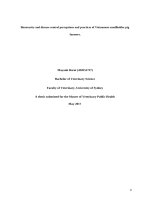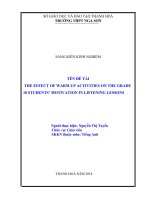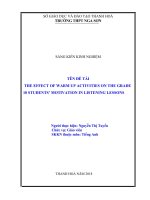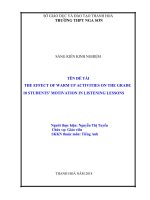Perceptions and practices of warm up activities by english teachers in thai nguyen
Bạn đang xem bản rút gọn của tài liệu. Xem và tải ngay bản đầy đủ của tài liệu tại đây (963.28 KB, 61 trang )
THAI NGUYEN UNIVERSITY
SCHOOL OF FOREIGN LANGUAGES
NGUYEN THI CHANG
PERCEPTIONS AND PRACTICES OF WARM-UP
ACTIVITIES BY ENGLISH TEACHERS
IN THAI NGUYEN
M.A THESIS
Field: English Linguistics
Code: 8220201
THAI NGUYEN – 2022
THAI NGUYEN UNIVERSITY
SCHOOL OF FOREIGN LANGUAGES
NGUYEN THI CHANG
PERCEPTIONS AND PRACTICES OF WARM-UP
ACTIVITIES BY ENGLISH TEACHERS
IN THAI NGUYEN
M.A THESIS
(APPLICATION ORIENTATION)
Field: English Linguistics
Code: 8220201
Supervisor: Le Thi Thu Huong, Ph.D
THAI NGUYEN – 2022
ĐẠI HỌC THÁI NGUYÊN
TRƯỜNG NGOẠI NGỮ
NGUYỄN THỊ CHANG
SỰ NHẬN THỨC VÀ THỰC TIỄN CỦA CÁC HOẠT
ĐỘNG KHỞI ĐỘNG BỞI GIÁO VIÊN TIẾNG ANH
Ở THÁI NGUYÊN
LUẬN VĂN THẠC SĨ
(Định hướng ứng dụng)
Ngành: Ngôn ngữ Anh
Mã số: 8220201
Cán bộ hướng dẫn: TS Lê Thị Thu Hương
THÁI NGUYÊN – 2022
i
DECLARATION
The writer fully declares that the research entitled “Perceptions and practices
of warm-up activities by English teachers in Thai Nguyen” is carried out by herself
with the purpose of fulfilling the requirement for the Master Degree of English
language at the School of Foreign Languages – Thai Nguyen University under the
guidance of Dr. LE THI THU HUONG. The results of this research have not been
submitted to any other universities for any other Degree or Diplomas before.
Approved by Supervisor Thai Nguyen, 2022
Student
Le Thi Thu Huong, Ph.D Nguyen Thi Chang
ii
ACKNOWLEDGEMENT
During the process of doing this research, it was so lucky for me to get
encouragement, support, and guidance from many people.
First of all, I am very grateful to my supervisor who has kindly given me
invaluable instructions, critical feedback, encouragement, and suggestions. Without
her guidance, it is impossible for me to complete this research.
Additionally, I also want to express my profound gratitude to all the lecturers
from Thai Nguyen University, School of Foreign Languages, and Postgraduate
Department. Who have brought me so many meaningful lessons and advice, to help
me have a proper orientation to do this research as well as a deeper understanding of
the English language.
Also, I want to send my thanks to the school board of Son Cam 1, Son Cam
2, Cao Ngan, Tan Long, and Hoang Van Thu secondary schools, all my colleagues,
and students at these schools for their support and participation during the process
of doing and collecting data for my research.
Besides, I also want to express my gratitude to my family and friends who
always motivate, support, and love me during the time of doing this research.
iii
TABLE OF CONTENTS
DECLARATION ........................................................................................................ i
ACKNOWLEDGEMENT ......................................................................................... ii
TABLE OF CONTENTS .......................................................................................... iii
LIST OF TABLES ......................................................................................................v
LIST OF FIGURES................................................................................................... vi
Figure 2.1: Principles of warm-up activities 9........................................................ vi
ABSTRACT ............................................................................................................ viii
CHAPTER I: INTRODUCTION................................................................................1
1.1. Rationale ...........................................................................................................1
1.2. Aims of the study..............................................................................................2
1.3. Research questions............................................................................................3
1.4. The scope and limitation of the study...............................................................3
1.5. Significance of the study ..................................................................................3
1.6. Thesis outline....................................................................................................3
CHAPTER II: LITERATURE REVIEW ...................................................................5
2.1. Some definitions ...............................................................................................5
2.1.1. Definitions of “warm-up”...........................................................................5
2.1.2. Definitions of perception............................................................................6
2.1.3. Definition of practice..................................................................................6
2.2. Warm-up ...........................................................................................................7
2.2.1. The benefits of warm-up activities.............................................................7
2.2.2. Principles of a warm-up activity ................................................................8
2.2.3. Examples of warm-up activities ...............................................................10
2.3. Teachers’ Perception ......................................................................................12
2.4. Previous studies ..............................................................................................13
CHAPTER III. METHODOLOGY ..........................................................................16
3.1. Research methodology....................................................................................16
3.2. The study setting.............................................................................................16
iv
3.3. Participants......................................................................................................17
3.4. Data collection instrument ..............................................................................18
3.4.1. Questionnaires ..........................................................................................18
3.4.2. Observation ..............................................................................................18
3.4.3. Interviews .................................................................................................19
3.5. Data collection procedure ...............................................................................20
3.5.1. Preparation................................................................................................20
3.5.2. Implementation.........................................................................................21
3.5.3. Planning for data analysis.........................................................................21
3.6. Data analysis ...................................................................................................21
CHAPTER IV: FINDING AND DISCUSSION ......................................................23
4.1. Findings ..........................................................................................................23
4.1.1. Result of the questionnaires .....................................................................23
4.1.2. Results of observation ..............................................................................26
4.1.3. Result of the interviews............................................................................30
4.2. Discussions .....................................................................................................37
4.2.1. What are English teachers’ perceptions on the use of warm-up activities
in English classes?..............................................................................................37
4.2.2. How do the English teachers implement warm-up activities in their
classes? ...............................................................................................................37
CHAPTER V: CONCLUSIONS...............................................................................39
5.1. Conclusion ......................................................................................................39
5.2. Limitations and recommendations..................................................................40
5.2.1. Limitations................................................................................................40
5.2.2. Recommendations ....................................................................................40
REFERENCES .......................................................................................................... 42
APPENDIX I............................................................................................................... I
APPENDIX II ............................................................................................................ II
APPENDIX III ......................................................................................................... IV
v
LIST OF TABLES
Table 3.1: Detailed participants ................................................................................17
Table 3.2: Main information of the teacher’s questionnaires ...................................18
Table 3.3: Details of the class observation ...............................................................19
Table 3.4: Main information of the teachers’ interview ...........................................20
Table 4.1: The perceptions and practice of using warm-up activities in English
classes ......................................................................................................23
Table 4.2: The types of warm-up activities..............................................................27
Table 4.3: The average time of the warm-up part....................................................27
Table 4.4: The participation of students in warm-up activities ...............................28
vi
LIST OF FIGURES
Figure 2.1: Principles of warm-up activities ...............................................................9
Figure 4.1: Types of frequently-used warm-up activities .........................................26
vii
LIST OF ABBREVIATIONS
Abbreviation Meaning
EFL English as Foreign Language
ESL English as a Second Language
SPSS Statistical Package for the Social Sciences
Q&A
Questions and Answers
viii
ABSTRACT
English is the most widely used language in the world, which has a great
influence on students’ future job opportunities. That is the reason why this subject
has been put into the curriculum of Vietnamese students at an early age with the
purpose of helping them master this language. There are many factors that affect
students’ ability and teaching method is one of the most important factors. Although
warm-up activities are not the key things in the teaching and learning method, it has
contributed to creating an effective learning environment and inspiring them to
learn. In this way, students can feel more relaxed before learning. This research
aims at investigating the perception and practice of warm-up activities by English
teachers in Thai Nguyen. A sample of 20 teachers from five different secondary
schools in Thai Nguyen city participated in this study. There were several data
collection instruments used, including teachers’ interviews, observation, and
questionnaires. The results of this research showed that all teachers have a positive
opinion towards using warm-up activities in their classes. They also applied
different warm-up activities with the purpose of drawing students’ interest. In
addition, all of the participants gave the idea that those activities should not last for
long. Besides, during implementation process, they had to face to some problems
which were illustrated in this study and steps that they took to deal with. Hopefully,
this study will make a small contribution to clarify the perception as well as the
practice of teachers in using warm-up activities in English classes.
1
CHAPTER I: INTRODUCTION
1.1. Rationale
In today's modern world, English has become a crucial part of our daily life.
It plays an extremely important role in all fields, especially in the context of
industrialization and modernization. English is now considered an international
language, which can be used as the main means of communication to communicate
with people from countries around the world. It has made a great contribution in
eliminating the language boundaries among countries. Being aware of its
importance, many countries have decided to consider it as a second language aside
from their mother tongue. Until now, English has become the most studied and used
foreign language in the world. To keep up with changes as well as find more
opportunities for Viet Nam’s develop, English has been put in the curriculum and
has become one of the most important school subjects at all school levels. In this
way, the important role of English has been shown clearly in our education system.
Vietnamese students start learning English quite early. Most Vietnamese
students are obliged to learn English from grade 3; however, this can be different in
regions. In some areas, pupils can start learning English earlier from kindergarten,
while others start learning at the secondary school level. Being exposed to English
early is beneficial for learners since it can be a concrete foundation to build up their
skills in the future. The earlier they start, the better their English skills are.
Vietnamese education has developed much compared to the past and there
are numerous effective teaching methods come out. To bring a proper learning
environment to students instead of boring and stressful lessons as before, different
methods have been applied in teaching English in Viet Nam. English is not the
mother tongue of the Vietnamese, so it is not easy for students to conquer this
language. When learning English, they may face numerous difficulties. Many
students are shy and get stressed, so they can’t learn well. The biggest challenge for
English teachers is how to get students involved in every lesson. It is clear that each
teacher will have their own way to catch students’ attention. Apart from having a
2
suitable teaching method, the first impression is very important, which plays as an
icebreaker to help learners feel more comfortable and interested in learning. To
attract students from the beginning, warm-up activities have been used in English
classes in Viet Nam in general and in Thai Nguyen in particular. Warm-up activities
can be games, songs, dances, watching videos, and so on.
A good start can bring energy, motivation, and joy instead of negative
feelings. According to Kay (1995), warm-up activities “are different activities
which are used to help students get involved into learning, start thinking in English
and review previous lessons”. It means warm-up activity is significant in creating a
positive learning environment and refreshing their brain to get ready for new
knowledge. Although warm-up is not the key part of the teaching process, it can
make the lesson more interesting and enjoyable. However, not all teachers can take
the best advantage of those activities in their class since they have different
opinions. Some teachers like to organize warm-up activities, but the others do not as
they want to focus on learning the lesson content only. Furthermore, implementing
this step is different in types, frequency, and steps.
The writer is also an English teacher in Thai Nguyen and has some
experience in teaching this foreign language. Throughout the writer personal’s
experience, the writer has seen that warm-up activities have been applied in almost
English classes in Thai Nguyen regardless of level. In addition to this, as an English
teacher, the writer also wants to gain a clear insight into effective techniques to
make them eager to learn. Furthermore, this is also a good way to learn more about
the opinion of her colleagues as well as their implementation.
All the above-mentioned reasons and factors have inspired me to conduct a
study entitled “Perceptions and practices of warm-up activities by English teachers
in Thai Nguyen”.
1.2. Aims of the study
This study aimed at exploring the perception by English teachers in Thai
Nguyen towards using warm–up activities and investigating the practice of warm-
up activities by English teachers.
3
1.3. Research questions
This study aimed at investigating the following two research questions:
1) What are English teachers’ perceptions on the use of warm–up activities
in English classes?
2) How do the English teachers implement warm–up activities in their classes?
1.4. The scope and limitation of the study
In Thai Nguyen province, there are many schools and English teachers;
however, due to time limitations, this study could mainly focus on using warm-up
activities of 20 English teachers in Son Cam 1, Son Cam 2, Cao Ngan, Tan Long,
and Hoang Van Thu secondary schools. The study only looked into teachers’
perceptions and practices in using warm-up activities. The other teachers, students,
and components of a lesson were not considered within this study.
1.5. Significance of the study
“Perceptions and practices of warm-up activities by English teachers in
Thai Nguyen” is the research that was expected to bring benefits to readers,
learners, and teachers.
For teachers, this study is a good resource for providing a deeper knowledge and
a closer look at warm-up activities to have more ideas to design creative lessons.
For learners, this study can help them understand more about the effects of
warm-up activities on their learning.
For readers, this study can be a reference source for those who want to learn
more about warm-up activities and who are looking for a reference source to
conduct research related to this topic.
1.6. Thesis outline
This study consists of 5 chapters as follows:
CHAPTER I. INTRODUCTION - consists of the rationale, the aims, the
research questions, the scope, the significance, and the research design.
4
CHAPTER II. LITERATURE REVIEW - covers the theoretical basis of,
including some definitions, the benefits of warm-up activities, examples, teachers’
perceptions, and some previous studies.
CHAPTER III. METHODOLOGY - presents the methods used to collect and
analyze the data. It includes the participants, instruments for data collection, and
data analysis.
CHAPTER IV. FINDINGS AND DISCUSSION illustrates the findings of
this research and then, discusses them.
CHAPTER V. CONCLUSION - provides a summary of the research
findings and suggestions for further research.
5
CHAPTER II: LITERATURE REVIEW
This chapter provides the related theoretical background to support this
study. There are five sections, including some definitions, warm – up activities,
examples, teacher perceptions and some previous studies.
2.1. Some definitions
2.1.1. Definitions of “warm-up”
Warm-up is considered as one of the most important stages in teaching
English as a second language (ESL), which contributes to the creation of a more
comfortable environment for learners. There remains a large number of ways to
define the term “warm-up”.
Depending on the field that we are learning about, the phrase “warm-up” can
be understood differently. In Oxford dictionary, warm-up is a phrasal verb, which is
used to talk about the preparation process for a performance or a physical exercise
by doing gentle activities. In the educational field, warm-up is also commonly used
to describe the first step of the teaching process in every lesson. In 2000, two
researchers whose names are Robertson and Acklam stated that “warm-up is a short
activity for the beginning of lesson”. Although a warm-up activity is short, it still
plays an integral part. Without it, a lesson can be bored and students may get
stressed. To add more information to the definition of the phrase “warm-up”, Kay
(1995) defined a warm-up activity as different activities which are used to help
student get involved in learning, start thinking in English and review previous
lessons. In Lassche’s opinion, warm-up acts as an “initial orientation”. It means that
a warm-up activity holds an important part in teaching and learning English, which
is organized at the beginning and orientates learners.
In short, a warm-up activity can be understood as using different activities
before starting a lesson to catch learners’ attention and help them prepare well for
the next stages of a lesson.
6
2.1.2. Definitions of perception
Perception is also defined by many researchers in the world. In Rundell’s
opinion (2007), a perception is what we think of, or how we understand something
based on our own assessment. In a similar way to Rundell, Hornby (2005)
demonstrated that perception is the result of seeing or understanding a process,
however, Hornby illustrated clearly how perception is expressed as images, ideas or
beliefs. In general, perception in the opinion of both Rundell and Hornby is our
understanding on which we base our judgments on specific things.
Through perception, the inner capacity of a person, including their attitudes,
feelings, and points of view can be determined (Baron-Cohen, 1995). According to
Robbin (2005), perception can be understood as a process in which people can be
engaged in organizing and deliver their sensory impressions with the purpose of
bringing meaning to the environment. Jalilah (2010) described perception as
“someone understanding, beliefs, feelings about persons, situations, and events as
his or her learning experience which will be the major determiner of his or her
stimuli to which the person responds”. In general, emotions, attitudes and
understanding are ways of perception expression. By these ways, we can show other
people our reaction to different issues.
To sum up, perception is simply understood as a sensory experience about
what a person becomes aware of.
2.1.3. Definition of practice
There are many different ways to define the word “practice”. In the
Oxford dictionary, practice means “doing an activity or training regularly so that
you can improve your skill” or “the time you spend doing this”. In this research,
practice can be understood as how teachers do warm-up activities in their classes
to help students develop their English skills and create a good atmosphere for the
next steps.
7
2.2. Warm-up
2.2.1. The benefits of warm-up activities
Warm-up has been studied by many researchers and they also figured out the
important roles of using warm-up activities in teaching English. It can be said that
warm-up activities bring numerous benefits to both educators and learners, such as
establishing a good relationship between teachers and learners, creating motivation
and catching attention.
Firstly, a warm-up activity is a bridge to establish a relationship between the
teachers and students. The learning process is different from any others, which
needs to be positive and motivation to help students learn more effectively. To have
a good relationship with students, it is necessary for teachers to break the ice by
using warm-up activities. Joshi (2006) suggested a list of warm-up activities, such
as a joke, a puzzle or games to create a positive environment for students as well as
make them feel more comfortable to learn. Hansen and Liu (2005) considered a
warm-up activity as an icebreaker activity which contributes to bring a relaxed and
comfortable environment and to generate peer trust for students. These activities
can bring success, which can help students make friends more easily, become more
opened and help teachers understand about their students’ level.
Secondly, warm-up activities inspire learners. Motivation is a very important
thing that can help students feel more interested in learning. According to Nseendi
(1984), “students will be motivated to learn when the activities and exercises for
language learning are interesting to them.”. As Nseendi said, if a teacher wants to
catch their students’ attention, they need to have interesting activities. Without those
activities, students may lose their interest in learning. Wisniewska (2012) also
agreed with Nseendi by saying that interest is a fundamental factor that affects
students’ comprehension. Interest can be created by motivation and encouragement,
and warm-up activities are the most effective ones in raising students’ interest.
Without warm-up activities at the beginning, creating a good environment becomes
more difficult for teachers.
8
Finally, warm-up activities can be used to catch students’ attention. Aside
from motivation, and relationship building, using a warm-up activity is one of the
best ways to make students concentrated on lessons. It is really hard for students to
maintain their attention in all day learning, which is the reason why they need an
activity to relax them and to avoid lack of attention and notice. Dornyei (2001) said
that “teachers can play a vital role to create a positive learning attitude among
students”. As Dornyei (2001) said in his research, teachers play an integral part in
creating positive learning environment and to do that, they will need activities to
inspire students to help them feel free to discover. By this way, learners can have a
good preparation for new lessons and focus more on what teachers are going to
teach. Similarly, Allwright (1984) indicated the significance of using warm-up
activities in language classes. He said that those activities are very useful in
catching students’ attention and help them eliminate distracting thoughts to fully
attend the class. In this day and age, everything has changed and teaching has been
subject to significant innovation, which has become learner – centered instead.
Teaching needs to focus on students, so it is essential to care about students’
attention in class, if the teachers want to have a successful lesson.
In short, warm-up activities are beneficial for both learners and educators.
They make a great contribution to narrow the gap between students and teachers in
the first period of any lesson as well as make them feel relaxed and comfortable to
start a new lesson.
2.2.2. Principles of a warm-up activity
Aside with the viewpoint of Velandia (2008), both Robertson and Acklam
(2000) also indicated the most important features of warm-up activities. In their
opinion, a warm-up activity is not the main part of a lesson, so it does not need to
last for long. They consider short activities to be a better idea. Similarly, they also
pointed out the importance of having interesting activities to motivate students since
this is the first step of a lesson. In the case, of it being boring, the students will have
a lack of interest in it and it will have bad effects on their learning in later stages.
9
There is only one thing that Robertson and Acklam did not agree with Velandia
about, was the relationship between the topic used in the lesson and warm-up
activity. They stated that the activity used for the warm-up does not need to match
with the topic that the students are going to learn because the main purpose of this
step is to get students ready at all times and become eager to learn English.
According to Velandia (2008), there are some principles that the teacher
should follow when designing a warm-up activity.
Be short
Be related to Go at the
the topic beginning
Be useful to Principles of Focus on
continue the warm up students’
activities attention
class
Be Prepare Help students
interesting students for a begin to
work
and period of
enjoyable concentration
activitiy
Figure 2.1: Principles of warm-up activities









